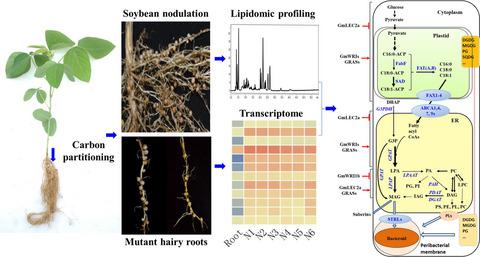Our official English website, www.x-mol.net, welcomes your
feedback! (Note: you will need to create a separate account there.)
Lipidomic and transcriptomic profiling of developing nodules reveals the essential roles of active glycolysis and fatty acid and membrane lipid biosynthesis in soybean nodulation.
The Plant Journal ( IF 6.2 ) Pub Date : 2020-05-15 , DOI: 10.1111/tpj.14805 Gaoyang Zhang 1 , Muhammad Z Ahmad 1 , Beibei Chen 2 , Sehrish Manan 2 , Yuliang Zhang 2 , Huanan Jin 2 , Xuemin Wang 3, 4 , Jian Zhao 1
The Plant Journal ( IF 6.2 ) Pub Date : 2020-05-15 , DOI: 10.1111/tpj.14805 Gaoyang Zhang 1 , Muhammad Z Ahmad 1 , Beibei Chen 2 , Sehrish Manan 2 , Yuliang Zhang 2 , Huanan Jin 2 , Xuemin Wang 3, 4 , Jian Zhao 1
Affiliation

|
Symbiotic rhizobia‐legume interactions are energy‐demanding processes, and the carbon supply from host cells that is critically required for nodulation and nitrogen fixation is not fully understood. Investigation of the lipidomic and carbohydrate profiles with the transcriptome of developing nodules revealed highly activated glycolysis, fatty acid (FA), 2‐monoacylglycerol (2‐MAG), and membrane lipid biosynthesis and transport during nodule development. RNA‐sequence profiling of metabolic genes in roots and developing nodules highlighted the enhanced expression of genes involved in the biosynthesis and transport of FAs, membrane lipids, and 2‐MAG in rhizobia‐soybean symbioses via the RAML‐WRI‐FatM‐GPAT‐STRL pathway, which is similar to that in legume‐arbuscular mycorrhizal fungi symbiosis. The essential roles of the metabolic pathway during soybean nodulation were further supported by analysis of transgenic hairy roots overexpressing soybean GmWRI1b‐OE and GmLEC2a‐OE. GmLEC2a‐OE hairy roots produced fewer nodules, in contrast to GmWRI1b‐OE hairy roots. GmLEC2a‐OE hairy roots displayed different or even opposite expression patterns of the genes involved in glycolysis and the synthesis of FAs, 2‐MAG, TAG, and membrane lipids compared to GmWRI1b‐OE hairy roots. Glycolysis, FA and membrane lipid biosynthesis were repressed in GmLEC2a‐OE but increased in GmWRI1b‐OE hairy roots, which may account for the reduced nodulation in GmLEC2a‐OE hairy roots but increased nodulation in GmWRI1b‐OE hairy roots. These data show that active FA, 2‐MAG and membrane lipid biosynthesis are essential for nodulation and rhizobia‐soybean symbioses. These data shed light on essential and complex lipid metabolism for soybean nodulation and nodule development, laying the foundation for the future detailed investigation of soybean nodulation.
中文翻译:

发育中的根瘤的脂质组学和转录组学分析揭示了活性糖酵解以及脂肪酸和膜脂生物合成在大豆结瘤中的重要作用。
共生根瘤菌-豆科植物的相互作用是一个需要能量的过程,而结瘤和固氮所必需的宿主细胞的碳供应尚不完全清楚。对发育中结节转录组的脂质组学和碳水化合物谱的研究揭示了结节发育过程中高度激活的糖酵解、脂肪酸(FA)、2-单酰基甘油(2-MAG)和膜脂生物合成和运输。根部和发育根瘤中代谢基因的 RNA 序列分析强调了通过 RAML-WRI-FatM-GPAT-STRL 参与根瘤菌-大豆共生体中 FA、膜脂和 2-MAG 生物合成和运输的基因表达增强途径,类似于豆科植物-丛枝菌根真菌共生。通过对过表达大豆GmWRI1b ‐OE 和GmLEC2a ‐OE 的转基因毛状根的分析,进一步支持了大豆结瘤过程中代谢途径的重要作用。与GmWRI1b ‐OE 毛状根相比, GmLEC2a ‐OE 毛状根产生较少的根瘤。与GmWRI1b -OE 毛状根相比, GmLEC2a -OE 毛状根在参与糖酵解和 FA、2-MAG、TAG 和膜脂合成的基因方面表现出不同甚至相反的表达模式。糖酵解、FA和膜脂生物合成在GmLEC2a-OE中受到抑制,但在GmWRI1b -OE毛状根中增加,这可能是GmLEC2a-OE毛状根中结瘤减少但在GmWRI1b -OE毛状根中结瘤增加的原因。这些数据表明,活性 FA、2-MAG 和膜脂生物合成对于结瘤和根瘤菌-大豆共生至关重要。 这些数据揭示了大豆结瘤和根瘤发育过程中必需且复杂的脂质代谢,为未来大豆结瘤的详细研究奠定了基础。
更新日期:2020-05-15
中文翻译:

发育中的根瘤的脂质组学和转录组学分析揭示了活性糖酵解以及脂肪酸和膜脂生物合成在大豆结瘤中的重要作用。
共生根瘤菌-豆科植物的相互作用是一个需要能量的过程,而结瘤和固氮所必需的宿主细胞的碳供应尚不完全清楚。对发育中结节转录组的脂质组学和碳水化合物谱的研究揭示了结节发育过程中高度激活的糖酵解、脂肪酸(FA)、2-单酰基甘油(2-MAG)和膜脂生物合成和运输。根部和发育根瘤中代谢基因的 RNA 序列分析强调了通过 RAML-WRI-FatM-GPAT-STRL 参与根瘤菌-大豆共生体中 FA、膜脂和 2-MAG 生物合成和运输的基因表达增强途径,类似于豆科植物-丛枝菌根真菌共生。通过对过表达大豆GmWRI1b ‐OE 和GmLEC2a ‐OE 的转基因毛状根的分析,进一步支持了大豆结瘤过程中代谢途径的重要作用。与GmWRI1b ‐OE 毛状根相比, GmLEC2a ‐OE 毛状根产生较少的根瘤。与GmWRI1b -OE 毛状根相比, GmLEC2a -OE 毛状根在参与糖酵解和 FA、2-MAG、TAG 和膜脂合成的基因方面表现出不同甚至相反的表达模式。糖酵解、FA和膜脂生物合成在GmLEC2a-OE中受到抑制,但在GmWRI1b -OE毛状根中增加,这可能是GmLEC2a-OE毛状根中结瘤减少但在GmWRI1b -OE毛状根中结瘤增加的原因。这些数据表明,活性 FA、2-MAG 和膜脂生物合成对于结瘤和根瘤菌-大豆共生至关重要。 这些数据揭示了大豆结瘤和根瘤发育过程中必需且复杂的脂质代谢,为未来大豆结瘤的详细研究奠定了基础。











































 京公网安备 11010802027423号
京公网安备 11010802027423号